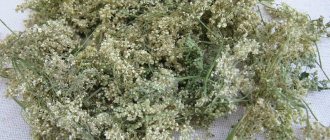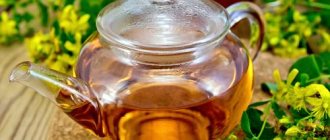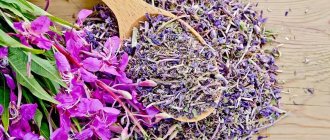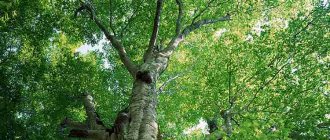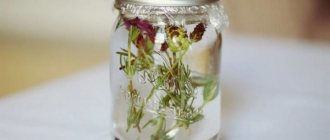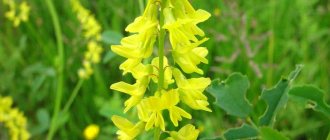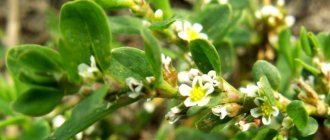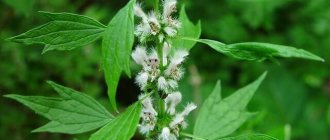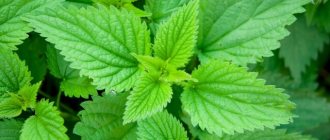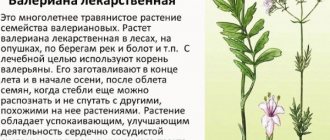This plant prefers hilly areas or wastelands, and grows especially readily on cliffs above rivers, where there is a lot of water. The leaves or flowers of coltsfoot are mainly used as medicine; they are often used as a collection in combination with other plants. For example, to combat cough, coltsfoot is combined with plantain or raspberries.
This plant got its amazing name because of its very specific temperature. Its leaves are bright green on one side and covered with a large amount of white fibers underneath. If you touch the green side of a leaf, you will feel that it is cool, regardless of the temperature around you. At the same time, the underside with fibers is very warm, and it is because of this that the plant received its unusual name.
What does coltsfoot look like and where does it grow?
The yellow, bright coltsfoot flowers are among the first to bloom in the spring, often as early as April. On stems covered with brown scales, one inflorescence opens. Small, tubular petals are collected in baskets of small diameter.
After flowering ends, palm-sized leaves appear, with large teeth along the edges. The upper part of the plate is smooth and glossy. The lower one is covered with white fluff, velvety, warm. For this property the grass was named coltsfoot. The Latin name says more about the application; it literally translates as “dispelling cough.”
The perennial prefers clay soils near water bodies, in vacant lots, and can settle in the garden. The beneficial coltsfoot grass is considered a weed and often grows in uncultivated lands.
Preparation and storage
- Leaves and flowers are collected separately.
- The leaves are suitable for harvesting in early June. The most valuable are the leaves of medium maturity (young and overripe ones should not be picked). They are dried in the shade, in a ventilated place, spread on paper or fabric in 1 layer.
- The flowers, or rather the yellow baskets without a stem, are collected in April-May and dried in the same way as the leaves.
- Store dried raw materials in fabric or paper bags in a dark, dry place. The leaves can be used for 3 years, and the flowers for 2 years.
Chemical composition of coltsfoot
The benefits of coltsfoot for the human body are determined by the complex balance of a large number of components in the composition. Medicinal properties have been found in flowers, seeds, roots and leaves of coltsfoot.
The main active substances in the herb and their beneficial properties:
- essential oils have antimicrobial, anti-inflammatory properties directed against viruses, fungi, and protozoa;
- mucus envelops the inner surface of the oropharynx, larynx, esophagus, stomach, intestines, promoting their healing and reducing swelling;
- phytosterones help build muscle mass, tone up, strengthen the body’s defenses, are antioxidants, and normalize cholesterol;
- glycosides exhibit the property of diluting bronchial secretions, promoting the removal of mucus from the respiratory system, and improving digestion;
- organic acids prevent cell wear, accelerate regeneration, treat purulent processes, strengthen the immune system;
- tannins disinfect, relieve inflammation, narrow and strengthen blood vessels, reduce bleeding;
- flavonoids, carotenes, saponins, sterols, inulin, rutin, vitamin C, and many other valuable compounds.
Important! The whole complex of substances that enhance and complement each other’s healing properties has a beneficial effect. Therefore, the range of uses of simple grass is simply huge.
How to properly prepare raw materials
Flowers and leaves are used for medicinal purposes; the coltsfoot root cannot be harvested.
When to collect - harvesting is carried out in dry weather in environmentally friendly places far from places of pollution - factories, highways, landfills.
Flowers - collected at the beginning of flowering, even before the leaves appear. They are cleared of debris and laid out in a small layer to dry. The collected raw materials are dried in a well-ventilated area without direct sunlight. Dried flowers are stored for 2 years.
Leaves – coltsfoot leaves are harvested after flowering, plucked by hand. After collection, they are dried in a darkened and well-ventilated room so that they dry evenly, they are laid out in a small layer and periodically turned over. Store for 3 years.
Why coltsfoot is useful
The actual property of coltsfoot is the treatment of coughs of any origin. Any part of the herb can enhance the production and removal of sputum, which is successfully used for dry coughs, bronchitis, pneumonia, and rhinitis.
The benefits of coltsfoot flowers are determined by the presence of essential oils, tannins, phenolic acids, and phytosterol. The substances destroy many pathogens and accelerate metabolism.
Coltsfoot leaves accumulate more plant mucilages, carotenes, vitamins, and microelements. Their benefits are more noticeable in the treatment of anemia, vitamin deficiency, and asthenia. The enveloping, antiseptic, healing properties of the herb are used externally and to help internal organs with damaged mucous membranes.
Plant composition
The basal leaves are mainly used for medicinal purposes. The mucus, which they contain in significant quantities, has an enveloping effect on the oral cavity, throat and larynx. In addition, young leaves are rich in:
- ascorbic acid;
- essential oils;
- saponins;
- bitter glycosides;
- tannins;
- organic acids (malic and tartaric);
- inulin;
- carotene.
Inflorescences are used less frequently in medicine, although they also contain valuable components:
- steroid compounds;
- tannins;
- flavonoids.
Saponins and organic acids are able to soften, dilute and remove mucus that accumulates in the upper respiratory tract during tracheitis and bronchitis.
Carotenoids, tannins and sterols help our body cope with inflammatory processes, reduce swelling of the mucous membranes and stop the development of pathogenic bacteria. Flavonoids and essential oils have an antispasmodic effect and alleviate the general condition.
What does coltsfoot treat?
An ordinary weed has outstanding qualities, can help in the treatment of several dozen diseases, strengthens a weakened body and even increases muscle performance.
Home remedies from coltsfoot are beneficial but do not cure diseases on their own. Herbal formulations are used as auxiliaries in the main therapy prescribed by the doctor. Unauthorized combination of medicinal substances can be harmful.
Coltsfoot grass is prescribed for the following diseases:
- any inflammation of the respiratory tract with cough, swelling of the mucous membranes;
- tuberculosis, asthma, emphysema;
- dermatitis, erysipelas, varicose veins, trophic ulcers, ulcers, wounds;
- stomatitis, periodontal disease, gingivitis, inflammation in the oral cavity;
- gastritis, enterocolitis, diseases of the stomach, intestines, hemorrhoids;
- inflammatory processes in the genitourinary system.
The general strengthening effect of coltsfoot remedies on the body can be useful for cardiovascular disorders and diseases of the nervous system. The immunostimulating, antihypoxic, antioxidant properties of the herb are used in recovery from illness.
Beneficial features
People have long known the beneficial properties of coltsfoot. This plant has been used for many centuries to combat various diseases, including diseases of the bronchi and lungs. It is recommended to be used regularly even by patients with asthma, because coltsfoot not only helps with a normal cough, thins mucus and promotes its removal, but is also able to relieve inflammation and swelling, and also support the body in the fight against harmful bacteria that cause diseases.
In addition, coltsfoot is used to treat problems of the genitourinary system. This is due to the fact that it helps fight painful spasms, helps fight bacteria and relieves unpleasant symptoms, including inflammation. Regardless of what diseases are observed in the genitourinary system, this herb can seriously improve the patient’s condition, relieve swelling and relieve pain.
Coltsfoot is no less known as a herb that can stimulate digestion and have a good effect on the organs of the digestive tract. Thanks to it, food is better absorbed, the normal flow of bile is stimulated, which leads to the normalization of the condition of the stomach and intestines as a whole.
Due to its bactericidal effect, ability to relieve inflammation and heal minor wounds, coltsfoot is very often used for various diseases of the mouth or throat. With regular use, coltsfoot really helps a lot, even healing small ulcers in the mouth.
It is for this reason that coltsfoot is often used to treat various types of skin diseases, especially those accompanied by abscesses.
Most often, a bath with this plant is used for this, and the decoction is also used as a lotion or for lotions. The combination of coltsfoot and nettle helps stimulate hair growth, fights dandruff well and generally improves the condition of the scalp when used as a mask. Chemical composition of coltsfoot (leaves)
| Ash | 10,2 % |
| Macroelements, mcg/g | |
| Potassium | 37,7 |
| Calcium | 10,9 |
| Manganese | 4,3 |
| Iron | 0,2 |
| Microelements, mcg/g | |
| Magnesium | 0,14 |
| Copper | 0,78 |
| Zinc | 0,6 |
| Cobalt | 0,27 |
| Molybdenum | 0,4 |
| Chromium | 0,03 |
| Aluminum | 0,07 |
| Selenium | 25 |
| Bromine | 107,1 |
| Bor | 40 |
| Silver | 8 |
| Iodine | 0,09 |
| Strontium | 0,01 |
Is coltsfoot beneficial during pregnancy?
The herb appears to be a harmless substitute for pills during pregnancy. But during the period of bearing a child, the medicine turns out to be not entirely harmless. The benefits and harms of coltsfoot herb must be carefully balanced for the mother and the fetus.
During pregnancy, the ability of alkaloids to penetrate the placental barrier is especially dangerous. This may harm the fetus, cause spontaneous abortion, or cause premature labor. During lactation, alkaloids pass into breast milk, so taking the herb orally is prohibited.
The composition of coltsfoot for pregnant women contains not only useful compounds. Alkaloids are harmful to a woman’s body. With prolonged use, they accumulate in the liver, destroying it. Herbal treatment lasting longer than 6 weeks causes harm.
It is acceptable to use coltsfoot during pregnancy to correct skin problems (acne, dermatitis) or hair care.
Mother and stepmother to children
Reviews about coltsfoot grass regarding the benefits and harms for children are quite contradictory. Some parents recommend it from the first days of a child's life. Doctors are more categorical. Due to the strong composition and the presence of poorly studied components, official medicine prohibits treatment before 2 years of age, when treatment will cause more harm.
It is useful to give a decoction or water infusion of the herb to children under 7 years of age for colds, coughs, fever, infectious diseases of the ear, nose and throat: 1 tbsp. l. up to 6 times a day. Only if the main treatment is selected by a pediatrician, a useful remedy from coltsfoot shortens the recovery time and copes with a lingering, unproductive cough.
Important! The useful amount of the product for school-age children is up to 250 ml per day. It is advisable to divide it into several steps.
Indications for use
Raw materials and herbs of coltsfoot, the properties of which have long been studied, are used as auxiliary therapeutic agents in the treatment of the following groups of diseases:
- Inflammatory diseases of the respiratory system: bronchitis, pharyngitis, sore throat, pneumonia, pulmonary tuberculosis, asthma.
- Acute respiratory diseases of a viral nature, including influenza.
- Diseases of the gallbladder, liver and biliary tract, pathologies of the gastrointestinal tract, urinary system, stomatitis.
- Cardiovascular diseases: coronary artery disease, stage 1-2 hypertension, atherosclerosis, inflammation of the superficial veins of the lower extremities.
- Diseases of the skin and its derivatives: burns, boils, purulent wounds, inflammatory rash, erysipelas, diathesis, scrofula, alopecia (hair loss).
Recipes with coltsfoot in folk medicine
If you need a softening, healing, enveloping effect, a herbal decoction is useful. When it is more important to preserve essential oils, glycosides, micro- and macroelements and their beneficial properties, it is better to make an infusion.
Coltsfoot decoction for cough and bronchitis
A decoction of coltsfoot herb is effective as an expectorant and emollient for acute and chronic bronchitis, tracheitis, and laryngitis.
Cough recipe:
- Crushed or crumbled leaves (1 tbsp) are poured into 0.5 liters of hot water.
- Warm up for no longer than 5 minutes.
- Leave covered until cool and strain.
Take the medicine in two doses - morning and evening, 250 ml before meals.
A stronger composition will be beneficial for problems in the gastrointestinal tract, to maintain heart function and vascular tone: 2 tbsp. l. herbs pour 1 tbsp. boiling water and boil for up to 15 minutes. The resulting product should be drunk in small portions throughout the day.
For diathesis, a decoction of the herb is prescribed to children over 2 years of age: 1 tsp orally. three times a day; externally - for wiping inflamed areas.
Infusion of coltsfoot
An infusion of coltsfoot is useful for rinsing the mouth, throat, and rinsing the nasal passages. The recipe is very simple: 1 tbsp. l. crushed raw materials are poured with boiling water (250 ml) and left for 20 minutes.
It is useful to take the strained composition 1 tbsp. l. up to 10 times a day for respiratory infections. You can rinse your mouth for dental inflammation or your throat for a cold with an infusion of herbs and flowers many times.
We recommend reading: Tea with thyme: beneficial properties and contraindications
Coltsfoot tincture with vodka
For the alcohol infusion you will need fresh coltsfoot flowers.
Preparation of tincture:
- The raw materials are mixed with high-quality vodka as 1:1 or with alcohol as 2:1.
- The mixture is poured into a glass container and sealed tightly.
- Leave for a week without access to light, otherwise the grass will lose its properties.
- Filter off the precipitate and store the alcohol solution in a dark place.
Dermatologists note the benefits of the tincture for acne. By treating your face several times a day, you can reduce the number of rashes in a few days. If it is noticed that alcohol irritates the skin, the product can be diluted with water. The benefit as an antiseptic will decrease slightly, but the harm will be minimal.
Coltsfoot tincture is taken orally: 20 to 30 drops before meals. Alcohol formulations of any herb can cause harm to a sore stomach and are contraindicated in alcoholism.
Tea from coltsfoot
Recommended reading: Benefits of milk tea
The benefits of coltsfoot tea are invaluable during the cold season. To prevent influenza, with a dry, prolonged cough, chills, brew 1 tbsp. l. flowers 1 tbsp. boiling water Useful herbs are used separately or as part of a collection, no longer than 3 weeks.
We recommend reading: Mint tea: beneficial properties and contraindications, how to make
Fresh coltsfoot juice
Fresh juice from young leaves has vitamin and healing properties if you collect the grass in June.
Application and beneficial properties:
- 1 tsp each up to 4 times a day for a course of at least 1 week for vitamin deficiency, loss of strength;
- 10 drops of juice into each nasal passage, up to 3 times a day for a severe runny nose;
- externally - for lichen, burns, ulcers on the skin, boils.
To prepare the product, the washed herb is crushed with a blender or passed through a meat grinder, the mixture is diluted with filtered water (50/50), and the beneficial liquid is squeezed out through cheesecloth.
Applications
Mashed fresh coltsfoot disinfects and heals when applied to damaged areas of the skin. Apply the herbal mass directly to the wound, burn, inflamed veins and cover with a clean cloth.
Leaves compress
The coltsfoot compress is prepared as follows: 5 tbsp. l. leaves with flowers are steamed with 1 tbsp. boiling water After infusing for half an hour, the steamed herb is ground. Gauze is placed on the skin, then the mass is applied evenly and covered with a cloth on top. It is useful to fix such a compress and leave it overnight. The course of treatment for significant damage is about 10 days.
Foot baths with coltsfoot
The antifungal, anti-inflammatory, tonic properties of the herb are beneficial for infections of the skin of the feet, calluses, wounds, and swelling.
Decoction for external use:
- Fresh or dried coltsfoot (2 tbsp) is poured with boiling water (2 l).
- Simmer on low heat for 45 minutes.
- Filter and cool to a comfortable temperature.
Take foot baths with herbal decoction for 15–20 minutes before bedtime. If the veins of the lower extremities are enlarged or blood vessels become brittle, it is recommended to regularly treat the surface of the legs with the same decoction.
Dried leaf powder
Finely ground herbs are convenient for treating wounds when other types of disinfection are not available. Coltsfoot powder, as a dry concentrate, can also be taken orally.
Comment! When drying and grinding raw materials, medicinal herbs quickly lose their beneficial properties, and sunlight is harmful to harvesting. Powders should be kept in a tightly closed container or prepared as needed.
Coltsfoot syrup
The medicine in the form of syrup is well stored in the cold, does not lose its properties for a long time, and children like it. In June, when the benefits of the herb are most pronounced, coltsfoot is prepared for the whole year.
A simple preparation: the juice from young leaves is mixed with powdered sugar. For 2 parts liquid – 1 part sugar or honey. Useful syrup from medicinal herbs is stored in the refrigerator.
Apply 1 tbsp. l. up to 4 times a day for tuberculosis, pneumonia, chronic bronchitis. Children are given 1 tsp. or tbsp. l. sweet medicine a day. The dose depends on age and pediatrician's recommendations.
Determination of the main groups of biologically active substances
Thin layer chromatography
Preparation of solutions
Standard solution (RM) rutin. About 0.001 g of rutin (rutin trihydrate) is dissolved in 10 ml of 96% alcohol. The shelf life of the solution is no more than 3 months when stored in a cool, dark place.
Diphenylboryloxyethylamine solution 1% in 96% alcohol. 1.0 g of diphenylboryloxyethylamine (diphenylboronic acid aminoethyl ether) is dissolved in 100 ml of 96% alcohol. The shelf life of the solution is no more than 3 months when stored in a cool, dark place.
- About 1.0 g of raw material, crushed to the size of particles passing through a sieve with holes measuring 1 mm (felt clumps of hairs that do not pass through the sieve are discarded), is placed in a conical flask with a ground section with a capacity of 100 ml, 10 ml of alcohol is added, heated to boiling water bath with reflux for 10 minutes. After cooling to room temperature, the resulting extract is filtered through a paper filter (test solution).
On the starting line of an analytical chromatographic plate with a layer of silica gel on an aluminum substrate measuring 10x10 cm, 20 μl of the test solution and a rutin CO solution are applied in the form of strips 1 cm long and no more than 3 mm wide. The plate with the applied samples is dried at room temperature for 15 minutes, placed in a chamber previously lined with filter paper from the inside and saturated for less than 30 minutes with a solvent mixture of ethyl acetate - anhydrous formic acid - water (40: 4: 6) and chromatographed using an ascending method. When the front of solvents has passed about 80 - 90% of the length of the plate, it is removed from the chamber, dried until traces of solvents are removed in a fume hood, and then viewed in daylight.
The chromatogram of the CO rutin solution should show a pale yellow zone.
The chromatogram of the test solution must show at least four absorption zones: two yellowish-gray adsorption zones; above them there are two bluish-gray zones, while one zone is twice as wide.
Then the plate is heated in a drying oven for 2-3 minutes at 100-105 ºС, while still warm, it is treated with a solution of 1% diphenylboryloxyethylamine in 96% alcohol and viewed in UV light at a wavelength of 365 nm.
The chromatogram of rutin CO solution shows a yellow fluorescent zone. The chromatogram of the test solution should show (from bottom to top from the starting line): two zones with yellow fluorescence; a zone with blue fluorescence, almost not separated from one of the yellow zones; two zones with blue fluorescence.
- About 10.0 g of raw material, crushed to the size of particles passing through a sieve with holes measuring 2 mm, is placed in a flask with a ground glass with a capacity of 500 ml, 200 ml of water is added, the flask is connected to a reflux condenser and boiled with stirring on a hotplate for 30 minutes. . The extraction is repeated 2 more times, using 200 ml the first time, 100 ml of water the second time. The aqueous extracts are combined and centrifuged at 5000 rpm for 10 minutes and decanted into a 500 ml volumetric flask through 5 layers of gauze placed in a glass funnel with a diameter of 55 mm and pre-washed with water. The filter is washed with water, the volume of the solution is adjusted to the mark with water and mixed.
a) Add 30 ml of 96% alcohol to 10 ml of the prepared solution and mix; flaky clots should appear that precipitate when standing (polysaccharides).
b) The solution with the precipitate is filtered through a POR 16 glass filter, the precipitate from the filter is transferred to a 50 ml volumetric flask with a 0.1 M sodium hydroxide solution and the solution is adjusted to the mark with it and mixed. To 1 ml of the resulting solution add 0.25 ml of a 0.5% carbazole solution and 5 ml of concentrated sulfuric acid, mix and heat in a boiling water bath for 10 minutes; a red-violet color appears (galacturonic acid).
Coltsfoot in home cosmetology
The coltsfoot herb, its decoctions and infusions are added to masks with a rejuvenating and lifting effect, to enrich creams, tonics, lotions, and hair products.
For facial skin
Coltsfoot preparations gradually but deeply cleanse pores, eliminate inflammation of small blood vessels, and treat acne. An alcoholic tincture of the herb has the property of whitening age spots and lightening freckles.
Cosmetic ice:
To 50 ml of decoction add 2-3 drops of rosewood essential oil and 10 ml of linseed oil. Enhances the beneficial properties by adding 10 ml of fresh coltsfoot juice. The ingredients are mixed and frozen in special forms.
Massage with ice cubes in the morning quickly relieves swelling and puffiness. Regular use restores the oval of the face, rejuvenates and refreshes the skin. But cryotherapy, instead of benefit, can cause harm in case of rosacea, enlarging spider veins.
Anti-wrinkle mask with seaweed: 50 ml of warm decoction of coltsfoot will require 30 g of crushed kelp. Preparation:
- Algae powder is mixed with liquid and left for 15 minutes to completely swell.
- Add 10 g of oil to the mixture and mix.
- The finished mass is distributed on the face and left for 30–40 minutes.
The mask has the ability to improve microcirculation in blood vessels, restore cells, enhance nutrition and oxygen saturation of the skin.
For hair beauty
An infusion of coltsfoot with nettle will help with severe dandruff and hair loss. Herbs taken 2 tbsp. l. each, pour a liter of boiling water, leave for half an hour, filter. Rinse hair after each wash.
Contraindications and side effects
Coltsfoot is a plant with powerful properties that can be beneficial or harmful. You need to drink it with caution, without increasing the dosage in recipes.
Contraindications to taking the herb:
- coltsfoot intolerance;
- renal failure, liver dysfunction;
- allergic diseases;
- pregnancy and lactation;
- age up to 2 years.
Between courses there is a break of 4 months. Long-term use without medical supervision does not bring benefit, but harm, disrupting liver function and poisoning the body.
Just a little botany
Coltsfoot, being a perennial herbaceous plant, is represented in nature by a single species - common coltsfoot. Its characteristic features include flowering before the appearance of leaves.
The fruits, ripened in May-June, are small oblong seeds with “parachutes” that fly away for many kilometers when the wind blows. The plant also reproduces thanks to its creeping root, forming dense thickets.
The leaves appear in the first half of summer - dense, round, soft and warm on the underside, like a “mother,” and cold and hard on top, like a “stepmother.” From this figurative comparison the Russian name of the flower came.
The scientific name Tussilago farfara L. is associated with the Latin words tussis - cough and agere - to remove, from which the primary use of the plant in the treatment of various respiratory diseases becomes clear.
However, not only bronchopulmonary ailments are treated by coltsfoot; there are also other recipes for its use in folk medicine, and all thanks to its special chemical composition.
Collection and drying of coltsfoot
The grass accumulates toxins, resins, and heavy metal salts. The harvesting of leaves and flowers should be done away from roads, enterprises, and polluted places. Toxic raw materials harm, not help, health.
Flowers are collected fully open, without stems. The leaves are torn off with a small petiole. The herbs are dried in the air, under cover from sunlight. If stored in tight packaging, away from light and moisture, the beneficial properties of coltsfoot will last for about 2 years.
TESTS
Humidity
Whole raw materials, crushed raw materials – no more than 13%.
Total ash
Whole raw materials, crushed raw materials – no more than 20%.
Ash, insoluble in hydrochloric acid
Whole raw materials, crushed raw materials – no more than 10%.
Raw material grinding
Whole raw materials: crushed particles passing through a sieve with holes measuring 2 mm - no more than 5%. Crushed raw materials: particles that do not pass through a sieve with holes measuring 7 mm - no more than 5%; particles passing through a sieve with holes measuring 0.5 mm - no more than 5%.
Foreign matter
The leaves are dark brown and have dark brown rust spots. Whole raw materials, crushed raw materials – no more than 8%.
Organic impurity. Whole raw materials, crushed raw materials – no more than 2%.
Mineral impurity . Whole raw materials, crushed raw materials – no more than 1%.
Heavy metals
In accordance with the requirements of the General Pharmacopoeia Monograph “Determination of the content of heavy metals and arsenic in medicinal plant materials and medicinal herbal preparations.”
Radionuclides
In accordance with the requirements of the General Pharmacopoeia Monograph “Determination of radionuclide content in medicinal plant materials and medicinal herbal preparations.”
Pesticide residues
In accordance with the requirements of the General Pharmacopoeia Monograph “Determination of the content of residual pesticides in medicinal plant materials and medicinal herbal preparations.”
Microbiological purity
In accordance with the requirements of the General Pharmacopoeia Monograph “Microbiological purity”.
quantitation
Whole raw materials, crushed raw materials: the sum of polysaccharides and free sugars in terms of glucose is not less than 10%.
Preparation of solutions.
Sodium hydroxide solution 40%. Dissolve 40.0 g of sodium hydroxide in 60 ml of water in a 100 ml volumetric flask. Cool under running cold water until completely cooled, adjust the volume of the solution in the flask to the mark with water and mix. The solution is allowed to settle and the clear liquid is drained from the sediment. The shelf life of the solution is 6 months when stored in glass packaging sealed with a rubber stopper.
Sodium carbonate solution 20%. 20.0 g of anhydrous sodium carbonate is dissolved in 60 ml of water in a 100 ml volumetric flask, the volume of the solution is adjusted to the mark with water and mixed. Filter if necessary. The shelf life of the solution is 2 months when stored in glass packaging sealed with a rubber stopper.
Picric acid solution 1%. 1.0 g of picric acid is dissolved in 50 ml of 96% alcohol in a 100 ml volumetric flask, bring the volume of the solution to the mark with 96% alcohol and mix. Store in glass packaging with a ground stopper, in a place protected from light, away from fire.
An analytical sample of raw materials is crushed to the size of particles passing through a sieve with holes measuring 0.5 mm. About 2.0 g (exactly weighed) of the crushed raw material is placed in a conical flask with a ground section with a capacity of 100 ml, 40 ml of water and 4 ml of concentrated hydrochloric acid are added, the flask is connected to a reflux condenser and heated in a boiling water bath for 30 minutes. Then the flask is cooled to room temperature under running cold water and filtered through 5 layers of gauze into a 100 ml volumetric flask. The remaining raw material in the flask is washed with 10 ml of water. The gauze with the remaining raw materials is placed in the same flask with the raw materials and the extraction is repeated one more time using the above method. The resulting extract is filtered through 5 layers of gauze into the same volumetric flask, the gauze is washed, the volume of the extract is adjusted to the mark with water and mixed (solution A).
Place 10.0 ml of solution A into a 50 ml conical flask, add 40% sodium hydroxide solution drop by drop to obtain a solution with a pH of 4.0 - 4.5. The solution is quantitatively transferred into a 50 ml volumetric flask, the volume of the solution is adjusted to the mark with water and mixed. The resulting solution is filtered through a paper filter (solution B), discarding the first 10–15 ml of the filtrate.
Place 2.5 ml of picric acid solution of 1% and 7.5 ml of sodium carbonate solution of 20% into a 100 ml volumetric flask and mix. 5.0 ml of solution B is placed in the same volumetric flask and the flask with its contents is heated in a boiling water bath for 10 minutes. Then the volumetric flask is cooled to room temperature under running cold water, the volume of the solution is adjusted to the mark with water and mixed (solution B).
As a reference solution, use a solution consisting of 2.5 ml of picric acid solution of 1%, 7.5 ml of sodium carbonate solution of 20% and 5 ml of water, placed in a 100 ml volumetric flask. The volumetric flask with its contents is heated in a boiling water bath for 10 minutes, then cooled to room temperature under running cold water, the volume of the solution is adjusted to the mark with water and mixed. The optical density of solution B is measured relative to the reference solution on a spectrophotometer at a wavelength of 470 nm in a cuvette with a layer thickness of 10.
The content of the sum of polysaccharides and free sugars in terms of glucose in absolutely dry raw materials in percent (X) is calculated by the formula:
where A is the optical density of solution B;
– specific absorption index of the glucose complex with picric acid at a wavelength of 470 nm, equal to 273.24;
a—weight of raw material, g;
W – raw material humidity, %;
Packaging, labeling and transportation
In accordance with the requirements of the General Pharmacopoeia Monograph “Packaging, labeling and transportation of medicinal herbal raw materials and medicinal herbal preparations.”
Storage
In accordance with the requirements of the General Pharmacopoeia Monograph “Storage of medicinal plant raw materials and medicinal herbal preparations”.
Download in PDF FS.2.5.0027.15 Coltsfoot leaves
